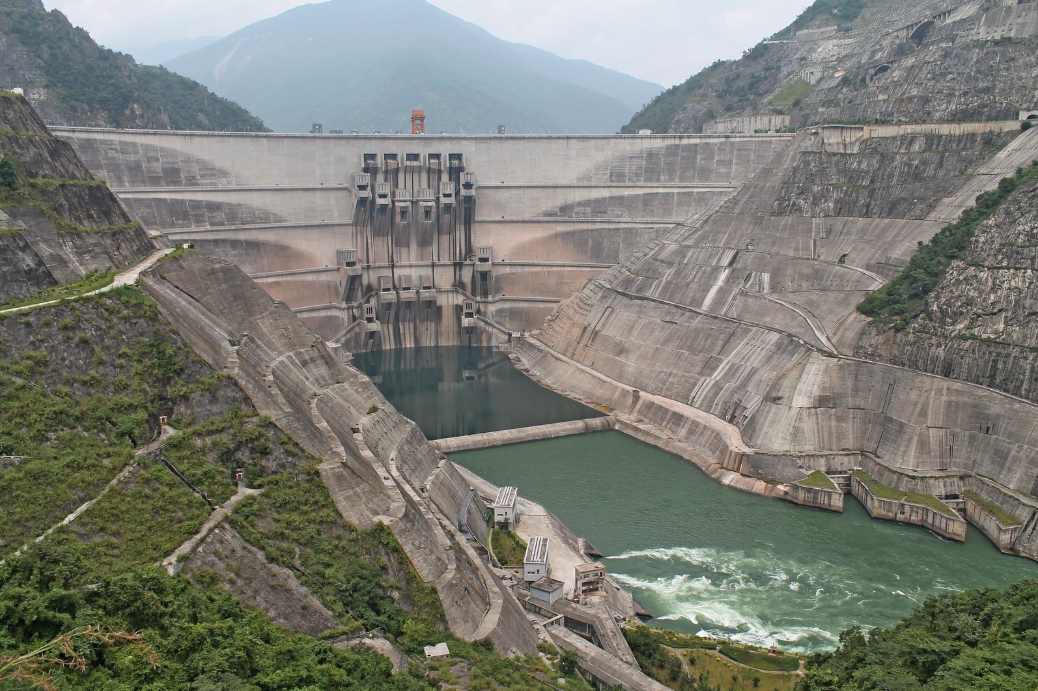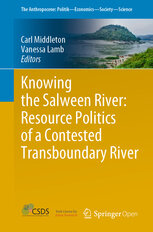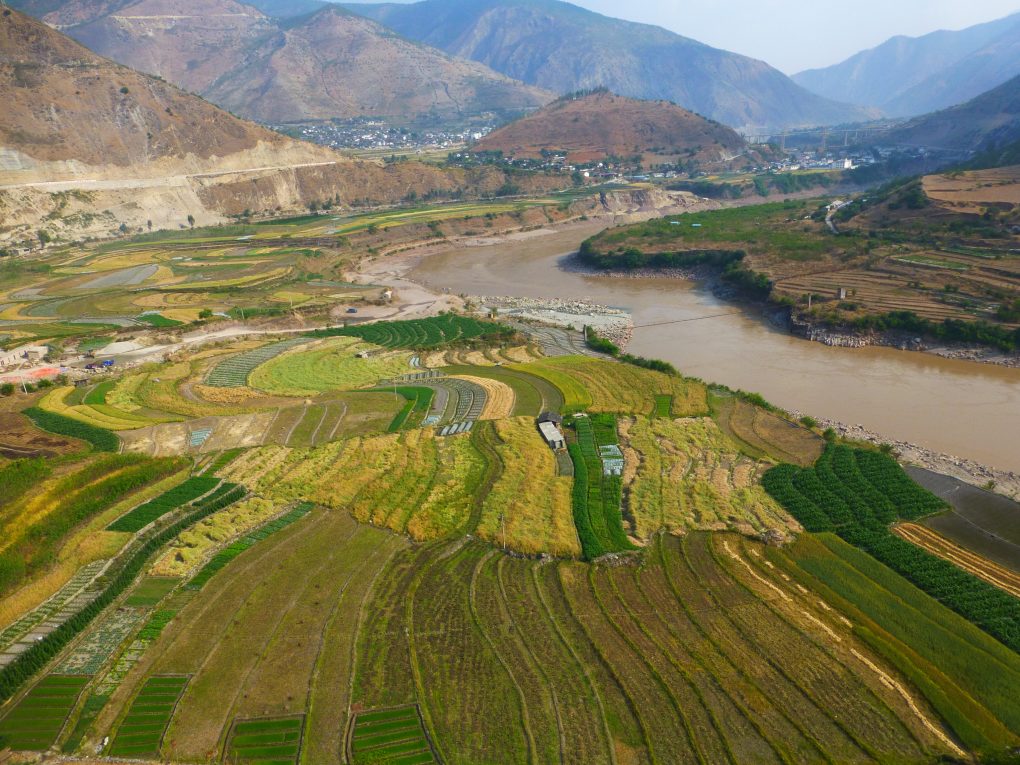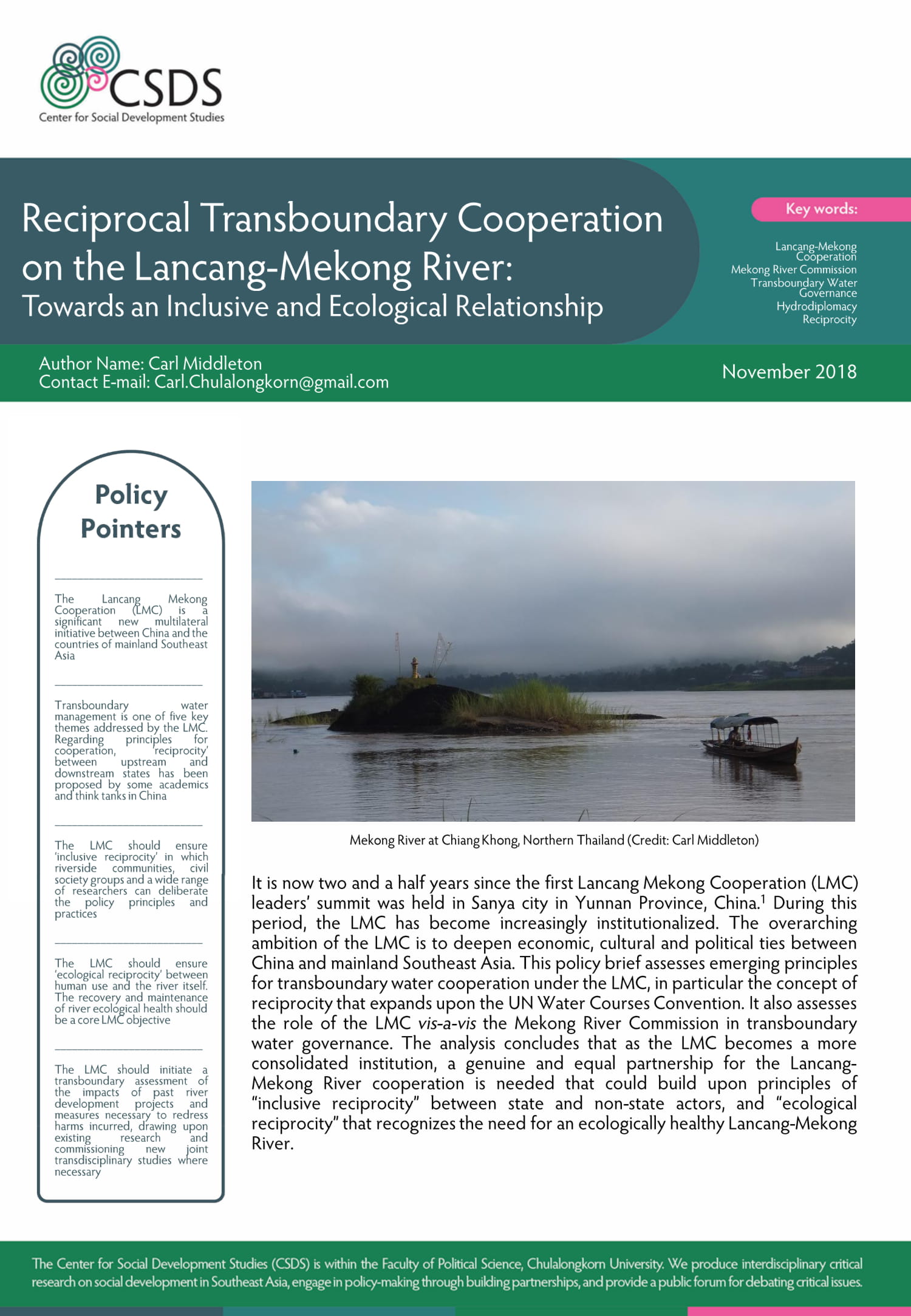We consider our results robust: the annual runoff estimated by the ensemble mean, 53.2 (+5.1/-4.9) km3, is in line with Räsänen et al.[xvii], who estimate the annual inflow to Jinghong as 58 km3 (1840 m3 s-1). We also find good correspondence when comparing to the observed streamflow at Chiang Saen during a natural flow regime (1960-1990). Our method estimates wet season runoff at Chiang Saen as 65.9 (+5.8/-5.0) km3, and annual runoff 79.6 (+7.3/-6.9) km3, while observed streamflow is 64.7 (+3.9/-4.0) km3 and 85.5 (+4.0/-4.5) km3, respectively.
By changing the research question and designing a methodology to address this question under data scarcity, we arrive at an opposite conclusion from the discussed reports – it seems likely that the upper Mekong Basin experienced drought-like conditions. If we accept the presented evidence showing the reservoirs at a high water level at the start of the 2019 wet season[ii],[vii], the Lancang cascade in China would have been overwhelmed by the inflowing water of an average wet season and would not have been able to prevent the flood pulse at Chiang Saen.
It should be noted that our approach, like the discussed EoE report, arises from incomplete data availability, and as a simple bucket model does not consider dam operations, transmission losses or water withdrawals. To further the debate, we make our code available for public review in GitHub[xviii]. However, an ensemble approach, like the one presented here, can facilitate discussion about modelling beyond questions looking for simple conclusions, and acknowledging multiple ways to overcome challenges[xix] inherent in hydrological modelling.
What can we do to address these shortfalls?
The issues we have highlighted here demonstrate the need for a constructive path forward, for which we propose four suggestions. First, open data-sharing is critical for comprehensive hydrological modelling of the Mekong. Without this, it is impossible to gain a true understanding of what is occurring across the basin, and opens the process up for unconstructive politicization and the closing of potential channels of dialogue[xx]. Unfortunately, China’s persistent lack of data-sharing with downstream countries, despite many assurances and invitations to share data[xxi], means that at the present time only such incomplete assessments of the impact of the upper dam cascade are possible. Thus, regardless of the shortcomings of research findings, China’s lack of transparency has brought about assumptions of dishonesty regarding its lack of release of water to downstream Mekong countries during the 2019 drought. In terms of data sharing, the ball is firmly in China’s court to act upon it.
Second, we emphasise the need for objective, credible science, particularly in such complex settings where there is a diverse range of perspectives, knowledge and agendas. From a hydrological modelling perspective, this can be achieved using a range of different model structures and assumptions which account for a wide range of plausible outcomes. This arises from acknowledging that there is no such thing as a ‘perfect’ model, and therefore uncertainty needs to be clearly communicated. Credibility of modelling can only be verified through a rigorous peer-review process and with the use of comprehensive model evaluation frameworks. Such frameworks acknowledge modelling as a social process[xxii], not merely a technical one.
Following from this is the need for a plurality of perspectives both within the scientific community across disciplines, and across society, as water resource sharing in the Mekong is debated. For example, increased inclusion of Chinese researchers would be highly beneficial, not just from a knowledge-perspective in ensuring rigorous debate, but also a diplomatic one to ensure that there is broad agreement – and constructive contestation - on how the analysis unfolds. Furthermore, when the intrinsically plural nature of knowledge is recognised, scientific advice can become more robust and democratically accountable[xxiii]. For this, we must also ensure research is inclusive of both physical and social sciences, and community knowledge.
Finally, research should be used as a catalyst for science-based policy discussions in the public domain, rather than the means toward a definitive answer that shuts down conversation. Despite their shortfalls, the EoE and Stimson reports have certainly achieved this. We, however, caution the oversimplification of findings in facilitating such discussion, to not undermine the credibility of science within public discourse.
Overall, we hope to see dialogue that is not one-way from ‘experts’ to the public, but rather an iterative process that encourages democratic debate. This requires a certain level of humility, both on the part of scientists and policymakers.
Concluding Remarks
The report from EoE and associated public discussion have connected China’s cascade of dams to the ongoing drought in the Mekong Region, and highlighted the role - and responsibilities - of scientists in untangling the complex web of environmental issues along the Mekong River.
As our analysis and commentary of others[viii],[ix] have demonstrated, there are weaknesses in the methodology used that undermine the claims that China completely held back the 2019 wet season flow. Our analysis suggests that it is improbable that China’s dam cascade can store an entire wet season’s worth of rainfall, and subsequently be the primary cause of the 2019 drought. But we agree that China could have alleviated the drought conditions by releasing more water from the reservoirs, even as it would be at China’s cost of sacrificing part of its underutilized electricity generation potential.
We therefore suggest a constructive path forward: (1) increase public availability of data which, (2) informs a wide range of rigorously-debated scientific studies across disciplines – an example of which we have provided here. (3) The subsequent scientific debates should be accountable to and informed by the needs of multiple groups across society, including communities and states. (4) Encourage and support evidence-based and democratized decision-making. Only through this can we hope to achieve cooperative and equitable sharing of water resources along the Mekong River.
Acknowledgment
We would like to thank Rajesh Daniel and Carl Middleton for their helpful comments and editorial review of this article.
—-
[i] Basist, A., and C. Williams. 2020. ‘Monitoring the Quantity of Water Flowing Through the Upper Mekong Basin Under Natural (Unimpeded) Conditions’. Sustainable Infrastructure Partnership, Bangkok.
[ii] Eyler, B. 2020. ‘Science Shows Chinese Dams Are Devastating the Mekong’. Foreign Policy (blog). 22 April 2020. https://foreignpolicy.com/2020/04/22/science-shows-chinese-dams-devastating-mekong-river/.
[iii] Beech, H. 2020. ‘China Limited the Mekong’s Flow. Other Countries Suffered a Drought.’ The New York Times, 13 April 2020, sec. World. https://www.nytimes.com/2020/04/13/world/asia/china-mekong-drought.html.
[iv] Reuters. 2020a. ‘Chinese Dams Held Back Mekong Waters during Drought, Study Finds’, 13 April 2020. https://www.reuters.com/article/us-mekong-river-idUSKCN21V0U7.
[v] Reuters. 2020b. ‘Mekong River Groups Urge China to Show Transparency after Dam Report’, 15 April 2020. https://www.reuters.com/article/us-mekong-river-idUSKCN21X1LG.
[vi] Eyler, B. and Weatherby, C. 2020. ‘New Evidence: How China Turned off the Tap on the Mekong River’. The Stimson Center. https://www.stimson.org/2020/new-evidence-how-china-turned-off-the-mekong-tap/.
[vii] Foreign Correspondent’s Club Thailand. 2020. ‘Mekong Update: New Evidence of China’s Dam Impacts, and Why It Matters | FCCThai’. 23 April 2020. https://www.fccthai.com/events/mekong-update-new-evidence-of-chinas-dam-impacts-and-why-it-matters/. Available at: https://www.youtube.com/watch?v=5YXLz4V-JbY
[viii] Ketelsen, T., J. Sawdon, and T. A. Räsänen. 2020. ‘Monitoring the Quantity of Water Flowing through the Upper Mekong Basin under Natural (Unimpeded) Conditions - Rapid Review’. Ho Chi Minh City, AMPERES. https://www.amperes.com.au/s/AMPERES-Review_Basist-et-al_Lancang-flows-19-April-2020.pdf.
[ix] Mekong River Commission. 2020. ‘Understanding the Mekong River’s Hydrological Conditions: A Brief Commentary Note on the “Monitoring the Quantity of Water Flowing the Upper Mekong Basin Under Natural (Unimpeded) Conditions” by Alan Basist and Claude Williams (2020)’. Mekong River Commission.
[x] Magee, D. and Hennig, T. 2017. ‘Hydropower Boom in China and along Asia’s Rivers Outpaces Regional Electricity Demand’. The Third Pole. https://www.thethirdpole.net/en/2017/04/28/hydropower-boom-in-china-and-along-asias-rivers-outpaces-regional-electricity-demand/.
[xi] The peer-review likely refers to: Basist, A., Williams, C., Ross, T.F., Menne, M.J., Grody, N., Ferraro, R., Shen, S. and Chang, A.T.C. 2001. ‘Using the Special Sensor Microwave Imager to Monitor Surface Wetness’. Journal of Hydrometeorology 2 (3): 297–308.
[xii] The purpose of monitoring dam operations.
[xiii] A rating curve is a mathematical model (equation) which describes the relationship between water level and discharge.
[xiv] We used 24 different combinations of Global Hydrological Models and reanalysis climate forcing datasets available from the Intersectoral Impact Model Intercomparison Project. These are generally uncalibrated model runs, so we complemented them with two global runoff products optimized with streamflow records: LORA and GRUN. For ISIMIP data, refer to Gosling, Simon, Hannes Müller Schmied, Richard Betts, Jinfeng Chang, Philippe Ciais, Rutger Dankers, Petra Döll, et al. 2017. ‘ISIMIP2a Simulation Data from Water (Global) Sector’. GFZ Data Services. https://doi.org/10.5880/pik.2017.010, for LORA refer to Hobeichi, Sanaa, Gab Abramowitz, Jason Evans, and Hylke E. Beck. 2019. ‘Linear Optimal Runoff Aggregate (LORA): A Global Gridded Synthesis Runoff Product’. Hydrology and Earth System Sciences 23 (2): 851–70. https://doi.org/10.5194/hess-23-851-2019, and for GRUN, refer to Ghiggi, Gionata, Vincent Humphrey, Sonia I. Seneviratne, and Lukas Gudmundsson. 2019. ‘GRUN: An Observations-Based Global Gridded Runoff Dataset from 1902 to 2014’. Earth System Science Data, March, 1–32. https://doi.org/10.5194/essd-11-1655-2019.
[xv] Total storage capacity 46.4 km3 was obtained from the WLE Greater Mekong Dam Observatory. We estimated the active storage by computing the ratio of total-to-active storage ratio from available values in Table 1 in Räsänen et al. (2017), and multiplying the total storage with the ratio 0.584 for higher, and 0.551 for lower estimate. Active storage capacity refers to the volume which is available for dam operators to work with. Dam data from Mekong Region Futures Institute. 2020. ‘Dataset on the Dams of the Greater Mekong’. Mekong Region Futures Institute, Bangkok. Active storage ratio from Räsänen, Timo A., Paradis Someth, Hannu Lauri, Jorma Koponen, Juha Sarkkula, and Matti Kummu. 2017. ‘Observed River Discharge Changes Due to Hydropower Operations in the Upper Mekong Basin’. Journal of Hydrology 545 (February): 28–41. https://doi.org/10.1016/j.jhydrol.2016.12.023.
[xvi] An ensemble mean is the average of a collection of many estimates. Here it refers to the average value of combining all of the 26 individual estimates.
[xvii] Räsänen, Timo A., Jorma Koponen, Hannu Lauri, and Matti Kummu. 2012. ‘Downstream Hydrological Impacts of Hydropower Development in the Upper Mekong Basin’. Water Resources Management 26 (12): 3495–3513. https://doi.org/10.1007/s11269-012-0087-0.
[xviii] https://github.com/mkkallio/Upper_Mekong_capacity_check
[xix] See e.g. Seibert, Jan, and H. J. (Ilja) van Meerveld. 2016. ‘Hydrological Change Modeling: Challenges and Opportunities’. Hydrological Processes 30 (26): 4966–71. https://doi.org/10.1002/hyp.10999, Fatichi, Simone, Enrique R. Vivoni, Fred L. Ogden, Valeriy Y. Ivanov, Benjamin Mirus, David Gochis, Charles W. Downer, et al. 2016. ‘An Overview of Current Applications, Challenges, and Future Trends in Distributed Process-Based Models in Hydrology’. Journal of Hydrology 537 (June): 45–60. https://doi.org/10.1016/j.jhydrol.2016.03.026 or Blair, P, and W Buytaert. 2016. ‘Socio-Hydrological Modelling: A Review Asking “Why, What and How?”’ Hydrol. Earth Syst. Sci 20: 443–478. https://doi.org/10.5194/hess-20-443-2016.
[xx] Pielke Jr., Roger A. 2007. ‘The Honest Broker: Making Sense of Science in Policy and Politics’. Cambridge Core. Cambridge University Press. April 2007. https://doi.org/10.1017/CBO9780511818110.
[xxi] See e.g. Biba, Sebastian. 2018. China’s Hydro-Politics in the Mekong : Conflict and Cooperation in Light of Securitization Theory. Routledge. https://doi.org/10.4324/9781315148663.
[xxii] See e.g. Hamilton, Serena H., Baihua Fu, Joseph H. A. Guillaume, Jennifer Badham, Sondoss Elsawah, Patricia Gober, Randall J. Hunt, et al. 2019. ‘A Framework for Characterising and Evaluating the Effectiveness of Environmental Modelling’. Environmental Modelling & Software 118 (August): 83–98. https://doi.org/10.1016/j.envsoft.2019.04.008.
[xxiii] Stirling, Andy. 2010. ‘Keep It Complex’. Nature 468 (7327): 1029–31. https://doi.org/10.1038/4681029a.
—-
Author Bio:
*Marko Kallio is working at Aalto University doing multidisciplinary research about water scarcity estimation in data scarce areas with a background in environmental engineering (water management, B.Sc.) and geoinformatics (spatial analysis, cartography, M.Sc.). He has been working in the Mekong Region in various projects as a modeller in hydrology and renewable energy, both as a consultant and as a researcher. Drawing from his experience in hydrological modelling and research, he has come to the conclusion that hydrological modelling is hard. This realization led to one of Marko’s main research interests – bridging the gap between modellers and consumers of the outputs of their models. For the past few years, he has developed intuitive methods for utilizing freely and openly available hydrological information in areas where data is scarce – like the Mekong Region. Marko has frequently visited the area in the past years and hopes his research can help in ensuring a sustainable future for the whole region. (Email: marko.k.kallio@aalto.fi).
**Amy Fallon is a researcher at Aalto University’s Water and Development Research Group. She has a BSc. in Environmental Sciences and an MSc. in Water Security and International Development. Her doctoral thesis focuses on resilience-based approaches to water governance in dynamic river basins undergoing significant social and ecological transformations. Using case studies from South Africa and Cambodia, her research highlights the importance of considering non-linear dynamics and uncertainty, as well as the role of politics and power, in decision-making processes. Her most recent work on Cambodia’s Tonle Sap Lake uses critical institutionalism to take a more critical perspective on resilience, focusing on the question ‘resilience for whom?’. Amy is interested in environmental justice, and the use of science to advocate for the most marginalised groups of society who are frequently the most impacted by environmental issues. (Email: amy.fallon@aalto.fi).














